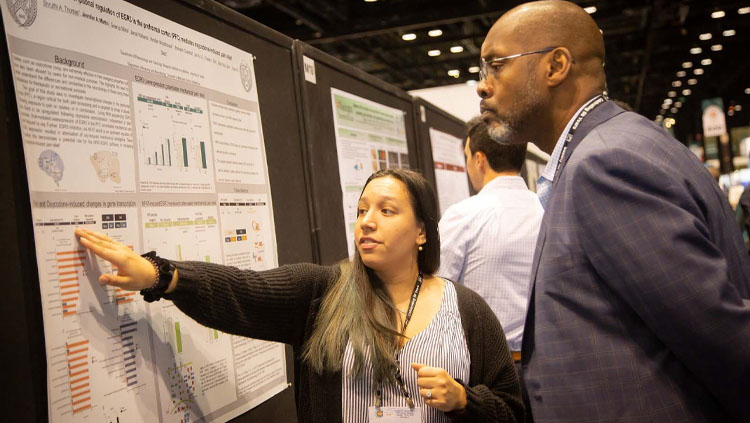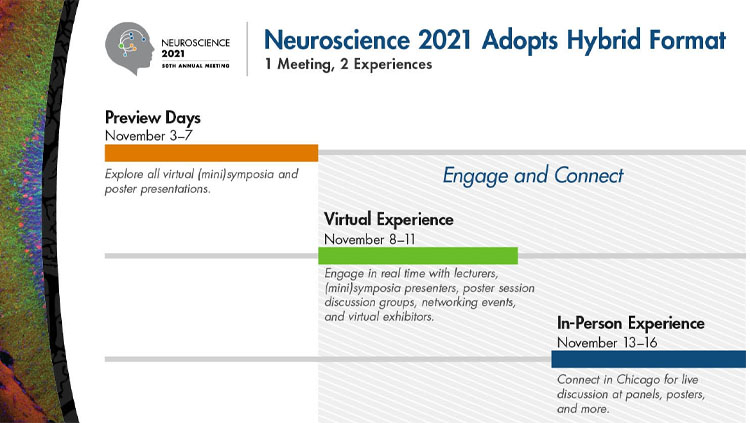What to Expect When Submitting an Abstract for Neuroscience 2021

Abstract authors have a lot to look forward to for Neuroscience 2021. With the annual meeting's new hybrid format, it is important to understand what abstract authors will need to create for a successful abstract presentation this year, as well as what they can expect during the meeting in November.
Abstract submission for Neuroscience 2021 is open July 6–15, 2021. The abstract requirements and submission process will be familiar to anyone who has submitted an abstract to a previous SfN annual meeting or the SfN Global Connectome in January 2021.
View a sample poster presentation from Adam Miller, Postdoc in Josselyn Frankland Lab.After an abstract has been accepted and sessioned by the SfN Program Committee, all authors will need to provide two unique pieces of content that are different than in the past: a PDF slide deck and five-minute video or audio recording. The recording should serve the purpose of offering a brief overview of the poster's content, like the summary offered by presenters to attendees wandering an in-person poster hall. Additional guidelines on how to develop a compelling recording will be provided in the near future. The PDF slide deck will provide a digital-friendly method of displaying the sections and details traditionally provided on a printed poster. Those abstract authors able to travel to Chicago for the in-person portion of Neuroscience 2021 will also need to develop a printed poster. View a sample poster presentation from Adam Miller, Postdoc in Josselyn Frankland Lab.
Poster presenters can expect a variety of engagement with other Neuroscience 2021 attendees. During "Preview Days" running November 3–7, the PDF slide deck and recordings for all posters will be available for viewing by attendees. Recordings will be grouped by poster session, allowing viewers to quickly scan the content of the 7–10 posters in each session. Attendees will be able to submit questions to abstract authors during the Preview Days and for two weeks after Neuroscience 2021, to which authors can respond at their convenience.
Unlike virtual poster sessions attended in other meetings, poster presenters will meet for a live virtual group discussion with poster-session peers during the "Virtual Experience" phase of the meeting, November 8–11. For one hour, the 7–10 presenters in a poster session will join a common virtual room to answer questions about their work from each other and any meeting attendees that stop by. This new engagement format provides abstract authors certainty knowing that their work will be seen and discussed by others. These 60 minutes of engagement will lead to unexpected insights, new networking opportunities, and open doors for future research.
Abstract authors able to travel to Chicago during the November 13–16 "In-Person Experience" portion of the meeting will also have access to SfN's dynamic poster hall. With a printed poster, in-person presenters will have a second opportunity to interact with meeting attendees, as well reintroduce themselves to their poster-session peers following the virtual group discussion the week earlier.
After submitting an abstract in July, authors and attendees can register for Neuroscience 2021 in early August. For the same fee, authors can register to attend virtually, or virtually and in person. Trainees can apply for a Trainee Professional Development Award (TPDA) which provides complementary registration and a stipend for travel and lodging for those traveling to the in-person program in Chicago.
Overall, the introduction of the virtual component to the SfN annual meeting offers an opportunity for neuroscientists to participate without having to secure both the time and resources necessary to travel to Chicago. And in this time of COVID-19 travel restrictions, virtual attendees from around the world can gain access to the annual meeting's complete scientific programming from their current location.
Learn more about the hybrid format of Neuroscience 2021, as well as the annual meeting's new schedule to maximize virtual engagement for a worldwide audience.






















